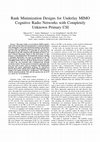Papers by Amitav Mukherjee
Abstract: This work investigates a fundamentally novel interweave cognitive radio network where t... more Abstract: This work investigates a fundamentally novel interweave cognitive radio network where the primary transmitter takes a proactive approach towards improving the accuracy of the spectrum sensing outcomes at the secondary users (SUs).
Abstract: This paper studies a novel underlay MIMO cognitive radio (CR) system, where the instant... more Abstract: This paper studies a novel underlay MIMO cognitive radio (CR) system, where the instantaneous or statistical channel state information (CSI) of the interfering channels to the primary receivers (PRs) is completely unknown to the CR. For the single underlay receiver scenario, we assume a minimum information rate must be guaranteed on the CR main channel whose CSI is known at the CR transmitter.
Abstract Current interest is centered on non-orthogonal resource sharing between device-to-device... more Abstract Current interest is centered on non-orthogonal resource sharing between device-to-device (D2D) and cellular user equipments (C-UEs) that share the same frequency band, which then requires careful interference management techniques to avoid degrading the quality-of-service of the C-UEs.
Abstract We investigate the secrecy outage performance for a cooperative unauthenticated relay ne... more Abstract We investigate the secrecy outage performance for a cooperative unauthenticated relay network where antenna selection is employed at the multi-antenna relay. Both traditional amplify-and-forward (AF) relaying and a cooperative jamming (CJ) protocol are studied. We characterize the exact secrecy outage probability (SOP) for the AF scheme, and analyze the asymptotic behaviour in terms of SOP for the CJ scheme.
Abstract This paper studies the transmit power-multiplexing tradeoff in MIMO systems when two use... more Abstract This paper studies the transmit power-multiplexing tradeoff in MIMO systems when two users with different priorities are to be accommodated simultaneously.
Abstract—We consider the deployment of an energy harvesting (EH) cooperative jammer (CJ) to incre... more Abstract—We consider the deployment of an energy harvesting (EH) cooperative jammer (CJ) to increase the security of a three-terminal wiretap channel with a passive eavesdropper, all users being equipped with multiple antennas. We first investigate the optimal offline EH CJ policy with complete non-causal information of energy arrivals and changes in channel state and show that it has an efficiently-computable global optimum.
Abstract—We investigate a relay network where the source can potentially utilize an unauthenticat... more Abstract—We investigate a relay network where the source can potentially utilize an unauthenticated amplify-and-forward (AF) relay to augment its direct transmission of a confidential message to the destination. Since the relay is unauthenticated, it is desirable to protect the confidential data from it while simultaneously making use of it to increase the reliability of the transmission.
Abstract—This paper studies a novel underlay MIMO cognitive radio (CR) network where the instanta... more Abstract—This paper studies a novel underlay MIMO cognitive radio (CR) network where the instantaneous or statistical channel state information (CSI) of the interfering channels to the primary receivers (PRs) is completely unknown to the CR. We first show that low-rank CR interference is preferable for improving the throughput of the PRs compared with spreading less power over more transmit dimensions.
Abstract This work investigates a fundamentally novel interweave cognitive radio network where th... more Abstract This work investigates a fundamentally novel interweave cognitive radio network where the primary transmitter takes a proactive approach towards improving the accuracy of the spectrum sensing outcomes at the secondary users (SUs).
Abstract The MIMO wiretap channel comprises a passive eavesdropper that attempts to intercept com... more Abstract The MIMO wiretap channel comprises a passive eavesdropper that attempts to intercept communications between an authorized transmitter-receiver pair, with each node being equipped with multiple antennas. In a dynamic network, it is imperative that the presence of a passive eavesdropper be determined before the transmitter can deploy robust secrecy-encoding schemes as a countermeasure. This is a difficult task in general, since by definition the eavesdropper is passive and never transmits.
Abstract We examine the design of a full-duplex active eaves-dropper in the 3-user MIMOME wiretap... more Abstract We examine the design of a full-duplex active eaves-dropper in the 3-user MIMOME wiretap channel, where all nodes are equipped with multiple antennas. The adversary intends to optimize its transmit and receive sub-arrays and jamming signal parameters so as to minimize the MIMO secrecy rate of the main channel. The full-duplex operating mode of the adversary induces self-interference at its receive sub-array, which is factored into the adversary's optimization.
Competition for limited bandwidth and power resources is an intrinsic aspect of multiuser wireles... more Competition for limited bandwidth and power resources is an intrinsic aspect of multiuser wireless communications, with ramifications in tactical ad hoc networks, legacy GSM cellular systems, forthcoming 4G Long-Term Evolution networks, and many more.
ABSTRACT The use of multiple antennas in mobile devices provides enhanced data rates at the cost ... more ABSTRACT The use of multiple antennas in mobile devices provides enhanced data rates at the cost of increased power consumption. The stochastic nature of the wireless propagation medium and random variations in the utilization and operating environment of the device makes it difficult to estimate and predict wireless channels and power consumption levels.
Abstract This work studies distributed linear transmission strategies for the multiple-input mult... more Abstract This work studies distributed linear transmission strategies for the multiple-input multiple-output (MIMO) interference channel with multiple concurrent links. We introduce the notion of interference self-mitigating beamforming (ISM-BF), where each transmitter minimizes the interference it causes to other users while satisfying its own signal-to-inter-ferenceplus-noise ratio requirement. The computation of the optimal transmit beamformers is shown to decouple into a generalized eigenvector problem.

We examine the design of a full-duplex active eavesdropper in the 3-user MIMOME wiretap channel, ... more We examine the design of a full-duplex active eavesdropper in the 3-user MIMOME wiretap channel, where all nodes are equipped with multiple antennas. The adversary intends to optimize its transmit and receive sub-arrays and jamming signal parameters so as to minimize the MIMO secrecy rate of the main channel. The full-duplex operating mode of the adversary induces self-interference at its receive sub-array, which is factored into the adversary's optimization. We characterize the worst-case jamming covariance for arbitrary and Gaussian input signaling, and develop a numerical algorithm to compute the same. We then examine sub-optimal active eavesdropping schemes that comprise essentially an antenna subset selection problem for the adversary, followed by a brief discussion of a potential countermeasure where the transmitter allocates some of its spatial dimensions for jamming the eavesdropper. Numerical results are presented to verify the efficacy of the proposed adversarial optimization algorithms.

The use of multiple antennas in mobile devices provides enhanced data rates at the cost of increa... more The use of multiple antennas in mobile devices provides enhanced data rates at the cost of increased power consumption. The stochastic nature of the wireless propagation medium and random variations in the utilization and operating environment of the device makes it difficult to estimate and predict wireless channels and power consumption levels. Therefore, we investigate a robust antenna subset selection policy where the power-normalized throughput is assumed to be drawn from an unknown distribution with unknown mean. At each time instant, the transceiver decides upon the active antenna subset based on observations of the outcomes of previous choices, with the objective being to identify the optimal antenna subset which maximizes the power-normalized throughput. In this work, we present a sequential learning scheme to achieve this based on the theory of multi-armed bandits. Simulations verify that the proposed novel method that accounts for dependent arms outperforms a naïve approach designed for independent arms in terms of regret.

This paper studies a novel underlay MIMO cognitive radio (CR) network where the instantaneous or ... more This paper studies a novel underlay MIMO cognitive radio (CR) network where the instantaneous or statistical channel state information (CSI) of the interfering channels to the primary receivers (PRs) is completely unknown to the CR. We first show that low-rank CR interference is preferable for improving the throughput of the PRs compared with spreading less power over more transmit dimensions. Based on this observation, we then propose a rank minimization CR transmission strategy assuming a minimum information rate must be guaranteed on the CR main channel. We propose a simple solution referred to as frugal waterfilling (FWF) that uses the least amount of power required to achieve the rate constraint with a minimum-rank transmit covariance matrix. We also present two heuristic approaches that have been used in prior work to transform rank minimization problems into convex optimization problems. We demonstrate that the direct FWF solution leads to higher PR throughput even though it has higher interference "temperature" (IT) compared with the heuristic methods. This calls into question the use of IT as a metric for CR interference.
We consider the deployment of an energy harvesting (EH) cooperative jammer (CJ) to increase the s... more We consider the deployment of an energy harvesting (EH) cooperative jammer (CJ) to increase the security of a three-terminal wiretap channel with a passive eavesdropper, all users being equipped with multiple antennas. We first investigate the optimal offline EH CJ policy with complete non-causal information of energy arrivals and changes in channel state and show that it has an efficiently-computable global optimum. Subsequently, an online CJ policy with causal side information and probabilistic energy constraints is presented and transformed into a conservative convex program with deterministic constraints. The impact of CJ on the secrecy rate of the MIMO wiretap channel is also quantified. Numerical examples for a range of energy arrival and array parameters show that EH cooperative jammers are generally effective in augmenting the security of the wiretap channel.

This work investigates a fundamentally novel interweave cognitive radio network where the primary... more This work investigates a fundamentally novel interweave cognitive radio network where the primary transmitter takes a proactive approach towards improving the accuracy of the spectrum sensing outcomes at the secondary users (SUs). For the single-primary-receiver scenario considered here, the multiantenna primary user constructs its transmit beamforming vector so as to increase the detection probability at the SUs while meeting a desired Quality-of-Service (QoS) target on its own link, by exploiting partial channel state information of the SUs. The objective of such a proactive approach, which we refer to as prescient precoding, is to minimize the probability of interference from SUs at the primary receiver due to imperfect spectrum sensing in fading channels. Numerical results are presented to verify the advantages of the proposed prescient transmission techniques for non-cooperative spectrum sensing scenarios.











Uploads
Papers by Amitav Mukherjee